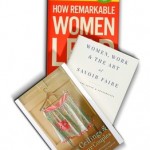Category Archives: Women@Work
Why Are Women-Owned Firms Smaller Than Men-Owned Ones?
![[SMCOVER]](http://si.wsj.net/public/resources/images/SM-AA333_SMCOVE_DV_20100514004329.jpg) The phenomenal growth of women-owned businesses has made headlines for three decades—women consistently have been launching new enterprises at twice the rate of men, and their growth rates of employment and revenue have outpaced the economy.
The phenomenal growth of women-owned businesses has made headlines for three decades—women consistently have been launching new enterprises at twice the rate of men, and their growth rates of employment and revenue have outpaced the economy.
So, it is dismaying to see that, despite all this progress, on average, women-owned business are still small compared with businesses owned by men. And while the gap has narrowed, as of 2008—the latest year for which numbers are available—the average revenues of majority women-owned businesses were still only 27% of the average of majority men-owned businesses.
While the number of women starting their own business outpaces men, revenue for female owned companies still lags behind. Hear Sharon Hadary, Former Executive Director and Founder of the Center for Women’s Business Research, discuss this trend and what women can do to improve their prospects.
There are those who will say that these numbers substantiate what they always knew: Women just don’t have what it takes to start and run a substantial, growing business. But I don’t buy that: More than a quarter of a million women in the U.S. own and lead businesses with annual revenue topping $1 million—and many of these businesses are multimillion-dollar enterprises. Clearly, many women have the vision, capacity and perseverance to build thriving companies.
So what’s holding back so many women business owners?
I have spent decades conducting research, studying the data and interacting with all the players involved—entrepreneurs, researchers, educators, bankers and others. And I am convinced that the problem is twofold. First, you have women’s own self-limiting views of themselves, their businesses and the opportunities available to them. But equally problematic are the stereotypes, perceptions and expectations of business and government leaders.
Understand: I’m not arguing that all entrepreneurs, all bankers, all policy makers are guilty of such limited thinking. But I’ve talked to enough of them, and studied enough of the research, to know that these problems are pervasive, and they are having a big impact—on both individual entrepreneurs and in turn on the health of the overall economy.
In that spirit, here’s a closer look at how I believe these factors are preventing so many women entrepreneurs from fulfilling their potential—and what can be done to prepare them to accelerate business growth.
Where the Problems Are
IT STARTS WITH THE GOALS: The value of setting high goals for growth is not just a motivational myth. Research shows that the only statistically significant predictor of business growth is not the industry, size of business or length of time in business. It is the entrepreneur’s goal for growth. View the rest of this posting
Study: Women Rock As Small Business Owners
Women are proving themselves to be a powerful small-business force to be reckoned with.
Not only are women-owned firms contributing $3 million annually to the U.S. economy and accounting for 16% of all jobs, but new research shows women entrepreneurs will create 5 to 5.5 million new jobs across the U.S. by 2018 – more than half of the total new small-business jobs expected to be created during that time, and about one-third of the total new jobs anticipated by the Bureau of Labor Statistics.
That research, recently released by The Guardian Life Small Business Research Institute, also shows that characteristics such as being more customer-focused, more likely to incorporate community into their business plans, and more adept at creating opportunities for others are helping women excel in 1) running a business 2) keeping employees driven and productive and 3) building a loyal customer base.
“As owners and managers, [women] are much more diligently engaged in the strategic and tactical facets in their business. They are more proactively customer-focused,†said Mark D. Wolf, director of the institute. Also, “they’re more intensive about saying things like, ‘I turn my customers into friends.’ Can you imagine the CEO of a major automotive business saying, ‘I turn my customers into friends?’â€
In fact, the only things that ranked higher for women than importance of their customers were family and religion. Women also were found, on average, to feel more strongly than men about creating a positive work environment, being able to pay employees better and making employees feel as if they are part of a team. The data also suggests women are more focused on making meaningful differences between themselves and their competitors, and are intent on finding ways to take advantage of their current economic situations. Experts say women also typically reach further into social networks and support systems for help in their business, and more often than men can finesse the art of multitasking, via their roles as caregivers at home and as bosses.
Experts say hopeful male entrepreneurs should take notes on what has been giving women business leaders an edge.
“If women are doing things that unleash peoples’ potential … and if someone has a choice between the two [a male- or female-owned firm] and starts to get wise …†Wolf said. “Men should probably look to owning and running their business more collaboratively and more as a team.
“While there certainly needs to be someone who makes the final decision … I think it’s the collaborative, all-inclusive approach where women have a much greater level of intensity about that they could learn from.â€
Many women business owners said they chose to start their own business – primarily in industries such as services, health care, communications and similar areas – because they were dissatisfied with the corporate track and sick of worrying about office politics. And another reason noted: the glass ceiling.
“There’s not a lot of opportunity for women to reach the executive level of boardrooms,†said Helen Han, president of the National Association of Women Business Owners (NAWBO). View the rest of this posting
On Women and Working
When Eileen Naughton was president of the Time Inc. magazine group, she got the news one afternoon that her young son had a genetic disorder that would prevent him from leading a normal life. Ms. Naughton, who was pregnant, also received a warning that her unborn daughter might be at risk. Before the news came through, Ms. Naughton’s biggest concern had been a speech she was scheduled to give the next day at an annual management meeting with the chairman sitting in the front row. The prospect had terrified her. Then the medical news she received put everything in perspective.
Ms. Naughton, now an executive at Google, is one of the women profiled in “How Remarkable Women Lead” (Crown Business, 355 pages, $27.50) an exploration of the traits that have helped a handful of women rise to the top in business, government and other fields, often while coping with personal and professional challenges. Written by two McKinsey & Co. consultants, Joanna Barsh and Susie Cranston, it is one of a trio of new books intended to help women navigate the still rocky road to success and achieve some kind of work-life balance.
Of the three, “How Remarkable Women Lead” is the most ambitious. It uses research from a five-year project to create a model for women to use in planning their careers. “Women, Work and the Art of Savoir Faire” (Atria Books, 261 pages, $24.99) is a more light-hearted affair. Written by Mireille Guiliano, the author of “French Women Don’t Get Fat” (2004), the book explores “business sense and sensibility,” offering wardrobe advice, entertaining and style tips, and even recipes for entertaining clients at home. (Chicken Provencal With Muscat Beaumes-de-Venise may be easier to cook than it sounds.)
The third book, Karine Moe and Dianna Shandy’s “Glass Ceilings and 100-Hour Couples” (University of Georgia, 215 pages, $19.95) looks at the flip-side of ambition and the repercussions of the “opt-out” phenomenon—women who jump off the workplace treadmill to become stay-at-home mothers after the reality of trying to “have it all” sets in.
These books were clearly conceived in better times, when choosing a fulfilling job or opting out to pursue full-time motherhood was the luxury of a booming economy. Now, of course, for millions of people—men and women alike—just holding onto a job or finding a new one is paramount. Some of the women profiled in “How Remarkable Women Lead” are now out of work themselves, and others are presiding over layoffs, downsizings and the effects of shrinking industries.
As for progressive companies that once embraced female-friendly flexible work hours and liberal leaves for family responsibilities, many are rethinking their policies. Such perks “are among the first to be cut under economic constraints,” according to Ms. Moe and Ms. Shandy in “Glass Ceilings.”
“How Remarkable Women Lead” has the whiff of a self-actualization treatise, but the McKinsey team, to its credit, does try to dissect what it is about women that sometimes holds them back in business. Women tend to take criticism personally, we’re told, rather than use feedback about poor performance as a source of insight and an aid to getting ahead. Women’s fear of speaking up in meetings allows men to dominate conversations, and (as studies show) women aren’t as adept at negotiating their compensation.
Another brake on career advancement, according to the McKinsey authors, is the tendency to build relationships based on friendship with like-minded individuals. Women may not be as skilled as men in building a broader, if shallower, network of colleagues and contacts. Ms. Barsh and Ms. Cranston note that men are also better at reciprocity—”you scratch my back and I’ll scratch yours”—which helps them make casual connections that are overtly transactional yet powerful, because both parties benefit. Women, by contrast, don’t like to impose on friends and so must be coached to think about strategic alliances.
To be effective leaders, though, women can tap into “feminine” strengths and exploit some of the “softer” aspects of office interaction. The ability to develop deep, authentic connections can also help women find mentors and sponsors to advance their careers and provide counsel.
“How Remarkable Women Lead” offers some interesting ideas, such as learning to frame events in a positive light and to adapt to setbacks with optimism rather than self-doubt and pessimism. But some of the book’s interviews with top executives—like Avon’s Andrea Jung, Xerox’s Anne Mulcahy and former Qantas chairman Margaret Jackson—are long on platitudes and short on the details of how these business leaders handled various challenges.
We learn that Ms. Jackson was hospitalized during a takeover bid for Qantas and gave an ill-advised quote about the bid to a journalist. But the authors don’t offer specifics— even though Ms. Jackson’s illness (deep-vein thrombosis) and what she actually said (a supporter of the take-over, she suggested that certain opponents had “mental problems with how the market works”) were widely reported at the time.
Ms. Naughton’s story at Time Inc.—her job was eliminated in a cost-cutting purge after Time Warner’s ill-fated merger with AOL, but she landed on her feet at Google— gives more insight into how to handle adversity. Her conclusion is that balance in life may not be achievable; the best that women can hope for is “organized disequilibrium.”
Mireille Guiliano, the former chief executive of French Champagne maker Veuve Clicquot, echoes many of the points made by Ms. Barsh and Ms. Cranston. But Ms. Guiliano’s “Women, Work and the Art of Savoir Faire” also offers a soupcon of practical guidance about getting ahead in business. Pick well-known companies to work for, she advises, and gain experience in a position with bottom-line responsibilities and a direct tie to revenue. These are no doubt good ideas—for those who find themselves in a position to snare such jobs.
Ms. Guiliano is at her most comfortable dispensing tips on style, wardrobe and business entertaining. Liberally sprinkling French phrases along the way (bien dans se peau—be comfortable in your own skin), she notes that women, much more than men, are judged by their appearance. For Ms. Guiliano the cardinal sin for any woman trying to get ahead is a lack of personal style—bad hair, for instance, or wearing flip-flops, jeans or see-through tops to work. (Twentysomethings, take note.)
A common thread in the three books is practical advice about taking care of yourself, advice that is as applicable to men as to women: getting enough sleep, rest and exercise; making sure that you take all your allotted vacation time. The authors also ask women to keep in mind a variety of self-protective measures, like taking safety precautions when traveling alone or, for married couples when the wife quits her job to pursue full-time parenting, signing a post-nuptial agreement to divide assets evenly.
The books agree that working women who are mothers usually have a second shift—they are the primary caregivers even when both spouses work. “Glass Ceilings and 100-Hour Couples” is especially sobering in its depiction of the challenges that women face in two-career families. Drawing on interviews, survey data and labor statistics, Ms. Moe and Ms. Shandy conclude that gender discrimination subtly pushes women with children out of the labor force.
Even when women stay on the job, they may find that having children limits their advancement. Women adapt by taking “bias avoidance” actions, like not requesting a reduced workload when they need it or hiding the fact that they are leaving work early to take a child to the doctor. At higher corporate levels, Ms. Moe and Ms. Shandy show, only 24% of women believe that they can turn down a work opportunity for family reasons without hurting their career. Most executive jobs, the authors conclude, remain structured for a stereotypical working man with a wife taking care of domestic matters.
When a woman does opt out of her career after deciding that the family can live on her husband’s income, the move doesn’t have to be the end of her engagement with the wider world, according to “Glass Ceilings.” Many professional women who become “stay-at-home” moms aren’t really staying home—they’re running with a pack of other smart women who have done the same thing, building social networks, serving in schools, helping their communities.
Not a bad way to for such women to keep their leadership skills honed—in case they decide to go back to work one day or start their own businesses. With the economy starting to warm up again, returning to the corporate world may soon be easier. “Glass Ceilings” makes a prediction: Before long, businesses will see the folly of under-using a powerful resource and will design policies that better accommodate capable, educated women who happen to have children.
Source: Wall Street Journal
EH9A4F8WXNRR
Intervista – Mirella Una Mental Trainer
In the introduction to her book, Daydreaming About Tea, Mirella M. P. Grillo writes, “A Chinese wise man says: ‘we drink tea to forget the noise of the world.’ In fact, there is no other drink, in nature, holding so many different properties. Tea sharpens and calms, cold or hot it is equally nice, available in a great variety of types. Tea is pleasant, warm and relaxing.”  In getting to know Mirella, and her work as a mental trainer, I believe one of her gifts is to help her clients focus on their dreams and ‘forget the noise of the world.’ In this spirit, it is with great pleasure that I introduce you to Mirella M. P. Grillo the 3rd Italian female entrepreneur featured in the Women @ Work series.
1)Â DA QUANTI ANNI AVEVI IL TUO TRAINING BUSINESS?
>Sono una Mental Trainer (una via di mezzo tra uno psicoterapeuta e un

formatore) e lavoro nel settore della comunicazione, con un occhio particolare per il suo lato psicologico, da 25 anni. Non tratto patologia ma tutto quello che ha a che fare con l’interagire, il saper parlare in pubblico, il saper dirigere un gruppo, il migliorare la propria leadership, ecc.
I’m a Mental Trainer, I’m in the middle between a psychotherapist and a coach, and I’ve been working in the communication area since I was 24. I’m not a doctor. My job is about the interaction with people, about public speaking, about the leadership, about how dealing with difficult people , about managing, and teamwork, etc.
2)Â PERCHE’ HAI COMINCIATO? PER ESEMPIO, AVEVI UNA PASSIONE PER CRESCITA PERSONALE OPPURE L’INDIPENDENZA CHE TI DA’ UN’ATTIVITA’ IN PROPRIO?
>L’idea è nata da un articolo che parlava di quanto una persona possa acquisire ulteriori capacità utilizzando in modo più appropriato le proprie capacità intellettive. E’ stato come aver incontrato una calamita. All’epoca già lavoravo ma ho ricominciato a studiare. E ora eccomi qua, una dei cinque Mental Trainer d’Italia. Amo il mio lavoro, ho quattro pubblicazioni alle spalle (la quinta è in elaborazione) e tanta gratificazione.
The idea was born from an article about the right use of our brain. For me it was as a magnet. At that time I worked as journalist but I started studying again and now I am one of the five Mental Trainers in Italy. I love my job. I wrote four books (the fifth is on the way) and a lot of satisfaction.
3)Â QUALE ESPERIENZA TI HA AIUTATO AD INIZIARE LA TUA ATTIVITA’? PER ESEMPIO: EDUCAZIONE,ESPERIENZA DELLA TUA VITA, ALTRI LAVORI,L’INSEGNAMENTO DEI TUOI GENITORI, ECC…
>Fondamentale è stato oltre ai miei studi, la mia autostima e la mia curiosità . E’ un modo per crescere in quanto si è consapevoli di non sapere. Socrate affermava che l’unica cosa che non sapeva era di non sapere, e interrogava di continuo sè e gli altri. D’altra parte i contributi offerti all’umanità da inventori e pensatori sono il risultato delle risposte alle continue domande che si pongono. Così in un certo senso ho fatto io.
A part of my studies, it was of prime importance my self esteem and my curiosity. It’s a way to grow up because we know we don’t know. Socrates said the he knew he didn’t know and he questioned himself and others. Inventors and philosophers gave their contributions to the humanity because they questioned themselves. So I did with me.
4) CHE CONSIGLIO DARESTI AD UNA DONNA CHE VUOLE INIZIARE LA PRORIA ATTIVITA’? PRATICAMENTE, CHE COSA HAI IMPARATO?
>Il mio suggerimento è che noi donne non dobbiamo mai abbandonare i nostri sogni. Abbiamo grandissime capacità , solo molte volte ci tarpiamo le ali da sole in quanto timorose del giudizio degli altri. Noi donne possiamo perchè abbiamo costanza e pazienza, siamo creative e flessibili, e quindi la capacità di concretizzare e vivere i nostri desideri.
I suggest that women mustn’t give up their projects, their dreams. We get several capabilities, but sometimes we clip us our wings because the people’s judgment. Women can because they get perseverance and patient, they are creative and flexible, and so we can realize and live our wishes.
Contatti: Mirella Grillo, Udine, Italia
Email: m_grillo3@yahoo.it
Intervista – Patrizia di Corpus

This 2nd installment of Women @ Work features Patrizia Cecchini the owner of Corpus. This is an energetic wellness and fitness center located in Perugia offering all different types of workouts including yoga. After a great workout, Corpus also offers lunch and a variety of healthy beverages.
DA QUANTI ANNI GESTISCI CORPUS?
>My husband and I started this business in January 1989.
PERCHE’ HAI COMINCIATO? PER ESEMPIO,AVEVI UNA PASSIONE PER BENESSERE OPPURE L’INDIPENDENZA CHE TI DA’ UN’ATTIVITA’ IN PROPRIO?
>Our passion for physical activity pushed us to open a fitness center.
QUALE ESPERIENZA TI HA AIUTATO AD INIZIARE LA TUA ATTIVITA’? PER ESEMPIO: EDUCAZIONE,ESPERIENZA DELLA TUA VITA, ALTRI LAVORI,L’INSEGNAMENTO DEI TUOI GENITORI, ECC…
>Everything started many years ago. We frequented a gym during our lunch break. From there came the initiative to start our own business.
CHE CONSIGLIO DARESTI AD UNA DONNA CHE VUOLE INIZIARE LA PRORIA ATTIVITA’? PRATICAMENTE, CHE COSA HAI IMPARATO?
>I’m not sure that I can give advice to a woman that wants to start her own business. Passion, believing in yourself and always giving 110% of yourself are the most important things for an entrepreneur. This business has taught
me to have a strong spirit, be willing to make many sacrifices and learn to relate with other people.
HAI UN CONSIGLIO PER TENERE IL PASSO CON LE TENDENZE PIU’ RECENTI?
>Tendencies? Many times tendencies become a style. But style does not always mean a healthy work.
COME STAI GESTENDO QUESTA CRISI ECONOMICA? ( PER ESEMPIO HAI CAMBIATO MARKETINGÂ OPPURE ALTRE COSE?)
>It is true, there has been crisis, but luckily with our staff, we are always able to reach the best solution to any problem to continue with our business. Luck? Maybe..but we like to think that it’s also due to our professionality.

Contatti: Corpus, Via Cortonese, 1/d, Perugia
Tel: 39.075.505.62.44
Web: CorpusClub.it
Building Your Business Wings
 Qualche volta devi solo saltare e iniziare a costruire le tue ali durante il tuo volo!â€Â Questa saggezza di Kobi Yamada mi ricorda il coraggio che deve avere una donna imprenditrice a stendere le sue ali mentre e’ in volo. Dopo quasi una decade nel mondo degli affari, combinata con il mio cinquantesimo anno, il mio punto di riflessione e’ centrato su questa topica. Cosi’, per onorare le imprenditrici donne coraggiose verra’ lanciata la serie di Women@Work . Per focalizzare questa discussione, gli Stati Uniti. Il centro degli Affari per le Donne ha fatto delle ricerche, ed ha riportato che:
Qualche volta devi solo saltare e iniziare a costruire le tue ali durante il tuo volo!â€Â Questa saggezza di Kobi Yamada mi ricorda il coraggio che deve avere una donna imprenditrice a stendere le sue ali mentre e’ in volo. Dopo quasi una decade nel mondo degli affari, combinata con il mio cinquantesimo anno, il mio punto di riflessione e’ centrato su questa topica. Cosi’, per onorare le imprenditrici donne coraggiose verra’ lanciata la serie di Women@Work . Per focalizzare questa discussione, gli Stati Uniti. Il centro degli Affari per le Donne ha fatto delle ricerche, ed ha riportato che:
- Il 51% o piu’ del mondo del business e’ posseduto da donne, con un totale di 7,2 milioni di società che impiegano 7,3 milioni di persone, e generano $1,1 trilione di vendite.
- Nel 50% o piu’ delle donne d’affari, si conta che il 40% possiede aziende private.
- Su 1,9 milioni di società , la maggioranza (51% o più) e’ posseduta da donne di colore, negli Stati Uniti impiegano 1,2 milioni di persone, e generano $165 miliardo di ricavo.
Senza dubbio, questa statistica stupisce! Ma la domanda, tuttavia, rimane: “Da qui, dove andremo?†Malcolm Gladwell (L’autore del che il libro, “Tipping Pointâ€) ci sfiderebbe di seguire il consumatore per il prossimo ” tipping point” [ punto di svolta].
Un’idea per il punto di svolta, e’ stata suggerita da un articolo del New York Times, “le Idee per un Piccolo Mondo” pubblicato il 9 maggio edizione Le Monde. Il quale cita delle societa’ che sono entrate nelle abitudini del consumatore e per le quali hanno cambiato la strategia degli affari. Un esempio: il desiderio per i più piccoli negozi di alimentari di ridurre le lunghe file e quindi di ridurre tempo di attesa , o sostituire i cataloghi e pubblicita’ cartacei con le chiavette USB (grazie Christie’s ) o ridurre il packaging al minimo indispensabile per rispettare l’ambiente (per esempio il Wal-Mart ha spinto questo con i loro venditori).
In quale modo la tua azienda sta riducendo le distanze geografiche cercando la prossima moda? Ci piacerebbe sentire una tua opinione.
Intervista – Emelita di Bijoux Nassi
La nostra prima intervista della serie “Women @ Work†e’ con Emelita Nassi. Si tratta di una imprenditrice di Perugia (Italia) che ha imparato l’arte

della vendita nel competitivo settore dei gioielli. Emelita e’ proprietaria di “Bijoux Nassi” a Perugia da 17 anni. Questa lunga esperienza dimostra la sua abilita’ di creare un rapporto duraturo con la clientela e di comprenderne i gusti durante le fasi dell’acquisto. La seguente intervista permette di comprendere il segreto del suo successo.
PERCHE’ HAI COMINCIATO? PER ESEMPIO, AVEVI UNA PASSIONE PER LA MODA O PER L’INDIPENDENZA CHE TI DA’ UN’ATTIVITA’ IN PROPRIO?
>Mio padre cessava l’attività di profumeria ed ho deciso di crearmene una mia di maggiore gradimento, con un franchising dell’articolo che preferivo, ampliando poi la scelta dei miei articoli acquisendo ditte che raggiungono vari targets di clientela.
QUALE ESPERIENZA TI HA AIUTATO AD INIZIARE LA TUA ATTIVITA’? PER ESEMPIO: EDUCAZIONE, ESPERIENZA DELLA TUA VITA, ALTRI LAVORI, L’INSEGNAMENTO DEI TUOI GENITORI, ECC…
>Il lavoro svolto nell’attività dei miei genitori, la collaborazione di mio marito, gli studi linguistici che mi permettono una facile comunicazione con la clientela turistica.
CHE CONSIGLIO DARESTI AD UNA DONNA CHE VUOLE INIZIARE LA PRORIA ATTIVITA’? PRATICAMENTE, CHE COSA HAI IMPARATO?
>Di credere fermamente in quello che fa, che se lo fa con serietà , verità ed onestà potrà realizzarsi come persona anche a costo di grandi sacrifici (per es. orari e distanza da eventuali figli).
HAI UN CONSIGLIO PER TENERE IL PASSO CON LE TENDENZE PIU’ RECENTI? CERTAMENTE USI LA TUA ESPERIENZA PER SEGUIRE LA MODA DELLE TENDENZE DI GIOIELLERIA..
>Il mio è un accessorio, deve per forza seguire le tendenze legate alla moda (abbigliamento); per la scelta mi fido di me…
COME STAI GESTENDO QUESTA CRISI ECONOMICA? ( PER ESEMPIO HAI CAMBIATO MARKETING OPPURE ALTRE COSE?)
>Con un controllo costante dell’andamento e una proporzionale riduzione degli acquisti; facilitando al massimo la clientela nella scelta e nei pagamenti.

Contatti: Bijoux Nassi, via Oberdan, 45, Perugia, Italia.
Tel. +39 075.57335894


 about the increased stress levels in the workplace due to the economic downtown. As a result of this stress, studies from the
about the increased stress levels in the workplace due to the economic downtown. As a result of this stress, studies from the 




